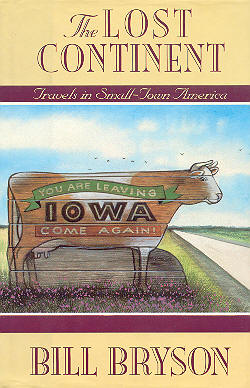The Lost Continent:
Travels in Small-Town
America
Bill Bryson

In two of the earlier issues of the Newswire, we reviewed books by Bill Bryson. This month, the featured book is one of that author’s earlier works; it is, in fact, his first book (published in 1989), titled The Lost Continent: Travels in Small Town America. It describes some of the author’s experiences while traveling across the U.S., and reflects his opinions about those experiences. At the time Bryson wrote Lost Continent, he was living in England; thus his reflections on what he found while traveling around his native land are often sharply and humorously drawn.
Following a visit to the Civil War battlefield at Gettysburg, PA, Bryson decided to take brief look at the home of Dwight and Mamie Eisenhower, who had owned a farmhouse just outside the town.
“Well, it was great. I can’t remember the last time I had such a good time in a Republican household. You are greeted at the door by a fragrant woman with a chrysanthemum on her bosom, who tells you a little about the house, about how much Ike and Mamie loved to sit around and watch TV and play canasta, and then gives you a leaflet describing each room and lets you wander off on your own so that you can linger or stride on as it pleases you. Each doorway was blocked off with a sheet of clear plastic, but you could lean against it and gaze into the interior. The house had been preserved precisely as it was when the Eisenhowers lived there. It was as if they had simply wandered off and never came back (something that either of them was quite capable of doing towards the end). The decor was quintessentially early 1960s Republican. When I was growing up we had some neighbors, the McGibbonses, who were rich Republicans and this was practically a duplicate of their house. There was a big TV console in a mahogany cabinet, table lamps made out of pieces of driftwood, a padded leather cocktail bar, French-style telephones in every room, bookshelves containing about twelve books (usually in matching sets of three) and otherwise filled with large pieces of flowery gilt-edged porcelain of the sort favored by homosexual French aristocrats.
When the Eisenhowers bought the place in 1950, a 200-year-old farmhouse stood on the site, but it was drafty and creaked on stormy nights, so they had it torn down and replaced with the present building, which looks like a 200-year-old farmhouse. Isn’t that great? Isn’t that just so Republican? I was enchanted.”
The author relates several more paragraphs about the Eisenhowers in this same vein; the reader can easily form a mental picture of the farmhouse and its contents, and even of the former inhabitants, with their foibles and eccentricities. Bryson’s great gift is for vivid imagery, whether he’s describing his first sight of the Grand Canyon on a snowy winter day, the incredibly tacky souvenirs to be found everywhere in the U.S. from the Smokies to South Dakota, or the amazing prices a hapless tourist pays to visit Colonial Williamsburg. Come along on a wacky, whimsical armchair tour of this great country -- be sure to read all about it!
All Rights Reserved.